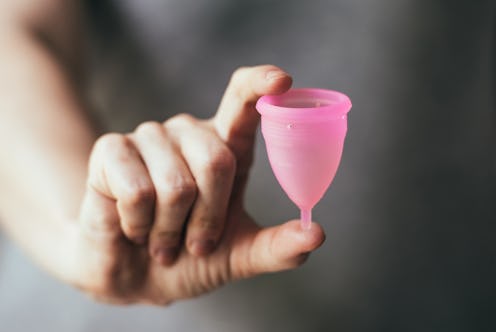Life
Do This To Make Sure You Never Get An Infection From A Menstrual Cup
Trying new things can be intimidating, especially when that new thing involves managing your period. If you’ve ever considered switching from your tried and true tampons or pads to a menstrual cup, questions like “Is it safe?” and “Can I get an infection from a menstrual cup?” have likely crossed your mind. When used correctly, menstrual cups are as safe as any other period product. As far as them causing infection, the short answer is: you probably won’t get an infection from a menstrual cup. The slightly longer answer? They can cause infection, but it’s not very likely.
Infections are caused by bacteria or other microorganisms invading your tissue, often through an abrasion in your skin. Common vaginal infections like bacterial vaginosis (BV) or yeast infections typically occur when there’s an imbalance of bacteria in your vagina, leading to a pH imbalance.
Basically, any time you put a foreign object into your body (i.e. a menstrual cup in your vagina), there is a chance unwanted bacteria could be coming along for the ride. However, if you’re using a clean menstrual cup and washing your hands prior to inserting it, you should be good to go. In fact, The DivaCup’s website says their menstrual cup has been found to be more sanitary than pads and tampons. But only if used correctly.
Again, the best way to avoid getting an infection is to wash your hands before putting it in. You’re more likely to get an infection from bacteria on your hands that was transferred via the menstrual cup than you are to get an infection from the menstrual cup itself.
In addition to just washing your hands, properly cleaning your menstrual cup is a solid way to prevent getting an infection. DivaCup recommends washing your menstrual cup a minimum of twice daily, roughly every twelve hours. Washing it with warm water and unscented, water-based soap will do the trick. You can also purchase menstrual cup wash if you’re worried about finding the right kind of soap.
For a deep cleaning, you can use boiling water and baking soda to clean your menstrual up once a month. Then, let it air dry, preferably in a sunny spot to prevent staining.
If you’re hoping to save time by sticking it in the dishwasher, don’t. Most menstrual cups are not dishwasher safe. Unless you want warped silicone that will entirely defeat the leak-free purpose of a menstrual cup, don’t clean yours in the dishwasher.
There isn’t much research that shows menstrual cups are linked to more yeast infections, though some in online message boards say that was the case for them. The same is true of urinary tract infections (UTIs). While some say they had more UTIs when they started using a menstrual cup, there isn’t current research that shows people who use menstrual cups are more likely to get UTIs than people who use other period products.
A report published in 2015 found one of the first confirmed cases of toxic shock syndrome (TSS) associated with menstrual cup use. TSS, a rare condition that often results from the presence of staph or strep bacteria, is typically associated with tampon use. However, TSS is incredibly rare, despite whatever horror stories you heard when you were first learning how to put in a tampon. Its rates have actually declined since tampon manufacturers have pulled certain period products off the market.
If unfamiliarity is making you hesitant to switch to a cup, you’re not alone. One study among Nepalese girls found that people were more likely to try a menstrual cup if they knew someone else who used one. You can rest assured that a growing number of people are using menstrual cups. In fact, one reason some people chose to switch to menstrual cups is because they don’t contain some of the chemicals that other period products have. So, if your body tends to be more sensitive or develops an allergic reaction to period products with fibers, something silicone-based like a menstrual cup may be a better option.
